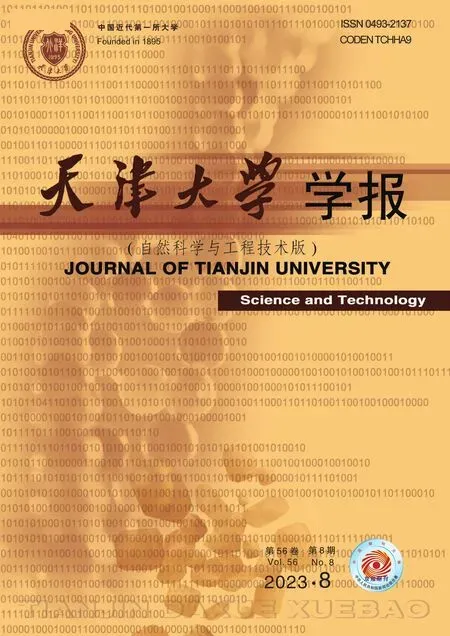纤维状海洋微塑料静水沉降实验研究
张金凤,唐千姿,陈 超,季超群,张庆河
纤维状海洋微塑料静水沉降实验研究
张金凤1, 2,唐千姿1,陈 超3,季超群1,张庆河1
(1. 天津大学水利工程仿真与安全国家重点实验室,天津 300072;2. 中国地震局地震工程综合模拟与城乡抗震韧性重点实验室(天津大学),天津 300350;3. 集美大学港口与海岸工程学院,厦门 361021)

海洋微塑料;纤维;静水沉降;沉降速度;沉降形态
海洋塑料污染已经成为全球性焦点问题[1-2].塑料垃圾被任意排放,由河口进入海洋,在海洋中漂流、悬浮和沉降,在这个过程中受到光照老化、波浪冲刷、微生物附着分解等作用,被分解成塑料碎片.这些塑料碎片经过长时间的物理、化学作用,又被分解成更小的塑料[3-4].Thompson等[5]首次提出微塑料的概念,即直径小于5mm的塑料纤维、薄膜和颗粒.根据种类的不同,微塑料的密度略小于或略大于水的密度,在海洋中漂浮或沉降[6],并在沉降过程中被动物摄入,再通过食物链传递到人体中[7],导致近年来在人体内部也检测出了微塑料[8].在最新的研究中,李昀东[9]通过实地调研统计了水体中微塑料的种类、形态和数量,研究发现水体中微塑料含量从大到小依次为纤维、碎片、薄膜和颗粒[10].
纤维状微塑料作为水体中含量最高的微塑料,主要包括聚酰胺(polyamide,PA)、聚酯(polyethylene terephthalate,PET)和聚丙烯(polypropylene,PP)[11-12]. Browne等[13]研究了纤维状微塑料在处理厂污水中的赋存情况,发现聚酯、聚丙烯和聚酰胺的占比分别为67%、17%和16%,这些比例与在海岸线发现的比例相似.这些纤维状微塑料的来源主要包括衣物洗涤过程中释放的合成纤维、烟蒂降解释放的醋酸纤维以及由于海啸造成海事设备破裂形成的碎片等[13-14].由于其来源众多,环境样本中纤维状微塑料的种类和尺寸不尽相同[15],所以对不同密度、直径和长径比的纤维状微塑料沉降特性的研究具有重要的意义.

本研究针对纤维状微塑料进行了静水沉降室内实验,得到了不同密度、直径和长径比纤维状微塑料沉降速度.在此基础上,将上述3个公式的计算值与实验值进行对比和分析.
1 实验材料与设备
1.1 纤维状海洋微塑料颗粒
海洋中纤维状微塑料含量从大到小依次为聚酯、聚丙烯和聚酰胺[13].由于聚丙烯的密度小于海水的密度,在海洋中与其他物质相互作用形成大颗粒体沉降,所以本文在研究纤维状微塑料单颗粒静水沉降时主要研究聚酯和聚酰胺两种材料,这两种材料在海洋环境中的赋存情况见表1.
针对聚酰胺材料,本文选用安徽联众刷业有限公司生产的PA纤维进行实验;针对聚酯材料,本研究选用同一公司生产的聚对苯二甲酸丁二酯(polybutylene terephthalate,PBT)纤维进行实验.根据表1,海洋环境样本中的纤维状微塑料的尺寸不尽相同[15],分布在0.02~5.00mm,所以本文选择中等大小即直径位于0.2~0.4mm和0.6~4.0mm的纤维状微塑料进行实验.
实验材料的具体性质参数见表2.PA纤维的密度为1.20g/cm3,实验采用的纤维直径约为0.4mm,长径比在2~4之间(图1(a));PBT纤维的密度为1.35g/cm3,实验采用的纤维直径约为0.2mm和0.4mm,长径比在3.0~8.5之间.实验所采用的纤维状微塑料均是未经老化的理想材料,比表面积较小,接触角较大,表面粗糙度较小,其表面性质决定了实验材料具有疏水性.此外,这两种微塑料颗粒都具有较高的光散射效率,易于拍摄得到沉降图像(图1(b)).
表1 全球范围内海洋环境中聚酯和聚酰胺纤维状微塑料的丰度和粒径分布情况
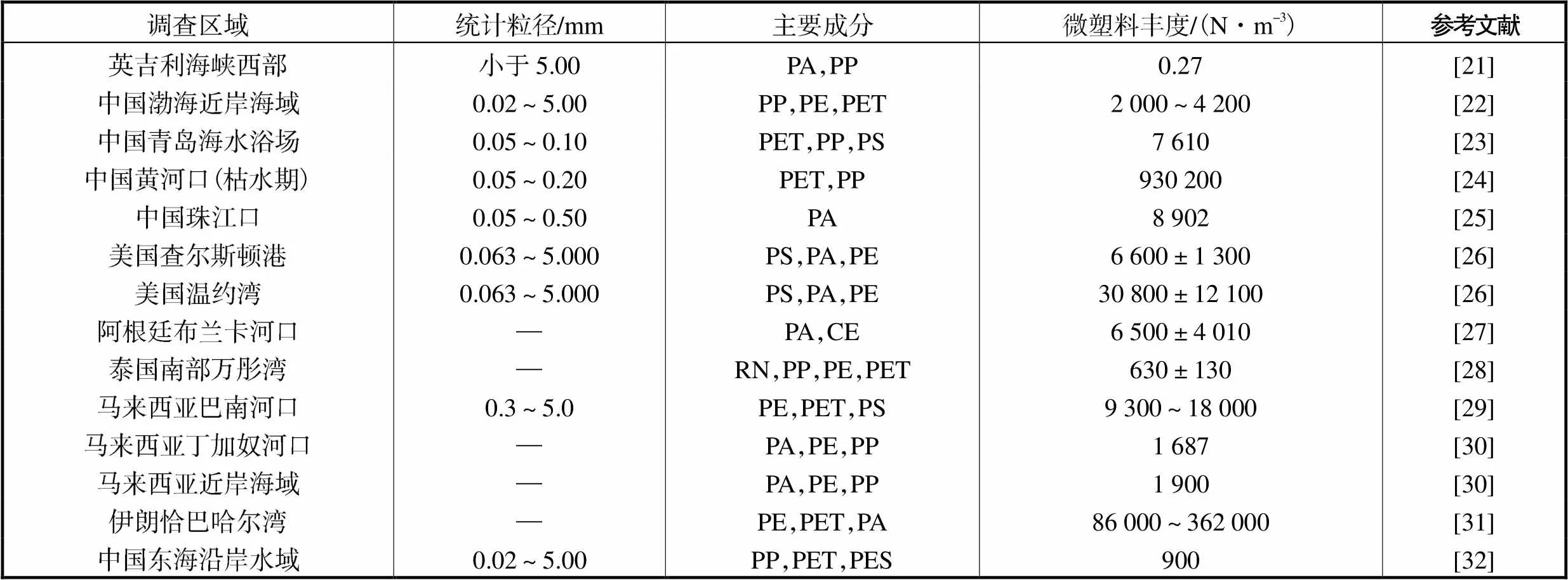
Tab.1 Distribution of abundance and particle size range of PET and PAfibrous microplastics in the marine environment on a global scale
表2 实验中纤维状微塑料物理性质

Tab.2 Physical properties of fibrous microplastics used in experiments

图1 实验中采用的纤维状微塑料
1.2 仪器设备
本实验在天津大学水利工程仿真与安全国家重点实验室中进行,采用的仪器设备包括方形有机玻璃沉降柱、高精度颗粒沉降观测系统(高速摄像机、同轴变倍镜头、LED冷光源)和高性能计算机.其中,方形有机玻璃沉降柱由有机玻璃制成,具有高透光度,长和宽均为113.5mm,高为1500mm.为使高速摄像机拍摄视野图像更明亮清晰,在其背部贴有反光铝箔纸.实验采用的千眼狼高速摄像机(Revealer 5KF20,Agile Device,中国)支持对全幅(1920×1080)进行3000帧/s的超高速摄像,长时间高速拍摄颗粒沉降,连续拍摄微塑料颗粒沉降过程.高速摄像机搭配的同轴变倍镜头采用大悦维佳(北京)科技有限公司生产的DMZH 0650,镜头连续无级可调,放大倍数在2.4~20.0倍之间.放大倍数越大,视野范围越小,实验根据所用的微塑料颗粒大小选择视野范围可捕捉、分辨率清楚的放大倍数.实验中的入射LED冷光源采用大悦维佳(北京)科技有限公司生产的MLED 500,最大功率60W,可手动调节亮度.LED冷光源通过光纤连接到同轴变倍镜头上,使高速摄像机拍摄得更为明亮.利用粒子图像测速法(particle image velocimetry,PIV)可以在不接触流体的情况下,同时记录大量空间粒子的位置分布,通过测量示踪粒子在已知很短时间间隔内的位移来测量粒子的瞬态速度分布,具有瞬态、多点、无接触式的特点.
实验中纤维状微塑料颗粒在沉降柱内静水沉降,到达底部时已处于稳定匀速下降的状态,故将高速摄像机及镜头布置在沉降柱底部10cm处,摄像机捕捉沉降画面并通过USB数据接口将拍摄画面传递到计算机上,从而实时观察并记录微塑料沉降过程.实验装置示意如图2所示.

图2 高精度颗粒沉降观测系统装置示意
2 实验方案
2.1 实验组次
以往的研究通过实地调研发现河口、海岸地区微塑料质量浓度范围为0~10mg/L[33].为了符合实际海洋环境,纤维状微塑料静水沉降室内实验将微塑料质量浓度选择为5mg/L,在这个浓度下微塑料的沉降状态接近于单颗粒自由沉降.根据纤维状微塑料密度、直径和长径比/的不同,每组实验重复3次,以保证捕捉到足够多的清晰可见的微塑料颗粒.实验组次见表3.
表3 纤维状微塑料静水沉降实验组次
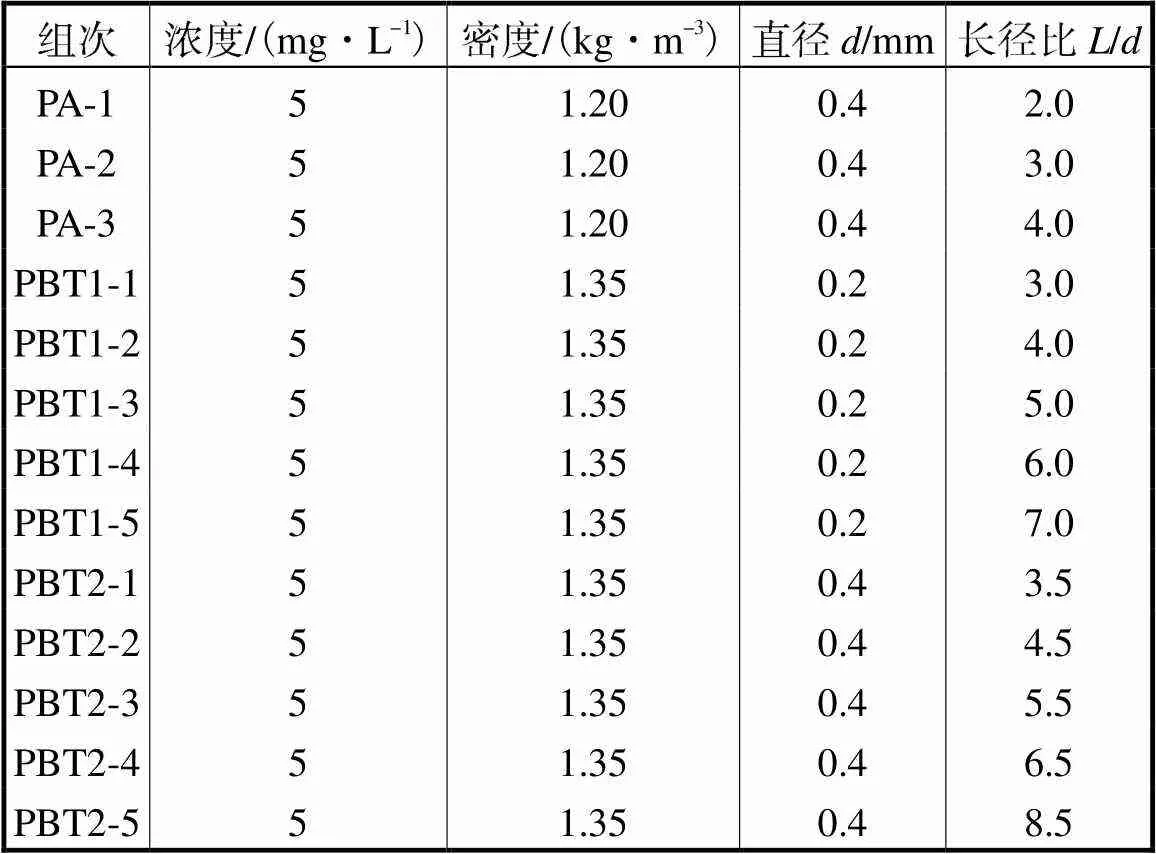
Tab.3 Settling experiment groups of fibrous microplastics in quiescent water
2.2 实验步骤
纤维状微塑料静水沉降实验分为实验预准备、实验过程和数据后处理共3个部分.
1) 实验预准备
实验预准备阶段需要对同轴变倍镜头进行像素尺寸标定,即每一个放大倍数对应一个固定的视野大小和像素尺寸,以便对数据进行后处理.分别准备3桶15L去离子水,将纤维状微塑料颗粒在去离子水中浸泡24h,并置于20℃恒温环境下,确保在实验前后水体温差控制在(20±1)℃.
2) 实验过程
使用磁力搅拌器,保持500r/min的转速,将准备好的浸泡有纤维状微塑料的模拟海洋水摇晃均匀,倒入方形沉降柱内,使微塑料颗粒自由沉降.在布置好的沉降柱底部以上10cm处拍摄纤维状微塑料的沉降运动过程,拍摄其稳定沉降状态下的沉降速度和形态.在观察到清晰颗粒的时刻,将拍摄的颗粒运动沉降过程保存为RHVD视频格式,每个实验组次进行3次平行实验.
3) 数据后处理
在拍摄到足够多的颗粒沉降过程视频后,将实验中保存的视频序列导入目标追踪测量软件VL 3.0中,并根据放大倍数完成坐标设置和像素尺寸标定.视频中每捕捉到一个清晰的微塑料颗粒,就对其进行手动框选,并利用VL 3.0软件的目标追踪功能得到其位置、速度和加速度等信息.
2.3 纤维状微塑料沉降公式
本文将纤维状微塑料的静水沉降实验值和3个现有研究提出的纤维状微塑料沉降公式计算值进行对比.
1) Komar公式
Komar[18]通过大密度圆柱体颗粒在甘油中进行静水沉降实验,提出了适用于低雷诺数的修正Stokes关系

2) Khatmullina-Isachenko公式
Khatmullina等[19]通过室内实验数据拟合了适用于圆柱体的微塑料半经验沉降公式

3) Waldschläger-Schüttrumpf公式
Waldschläger等[20]通过引入Corey形状因子,对阻力系数进行修正,得到了适用于圆柱体的微塑料半经验沉降公式为

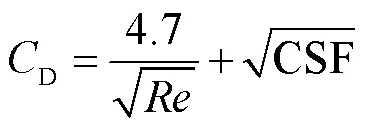

此外,本文对纤维状微塑料的等效粒径、沉降速度实验值和公式计算值进行无量纲化处理,从而更好地对比和分析颗粒粒径与沉降速度的关系.纤维状微塑料的无量纲颗粒等效粒径和无量纲沉降速度的计算式[19, 34-35]分别为
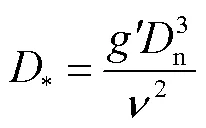
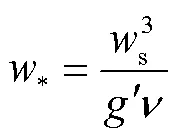
3 实验材料与设备
3.1 纤维状微塑料沉降速度
实验测量了直径约为0.4mm的PA纤维的沉降速度和直径约为0.2mm和0.4mm的PBT纤维的沉降速度.为了避免沉降实验的不确定性,在保证其他条件一致的情况下,每组实验组次进行了3组平行实验.以PA-1组次为例,3组平行实验的结果如图3所示,3组实验结果无显著差异性.

为了能够定量地对比和分析在实验粒径和长径比范围内3个公式的适用性和准确性,本文将纤维状微塑料颗粒静水沉降速度的实验值与Komar公式[18]、Khatmullina-Isachenko公式[19]以及Waldschläger-Schüttrumpf公式[20]的计算值无量纲化后进行比较,并统计了不同粒径和长径比下3个公式的平均相对误差.平均相对误差的计算公式[20]为

以实验组次PA-1为例,表4给出了该组次中各微塑料颗粒的无量纲沉降速度的计算值、实验值和相对误差.表中的无量纲沉降速度的计算值由式(1)~(7)得到,相对误差由式(8)计算.

图3 PA-1组次平行实验无量纲沉降速度分布

图4 直径约0.4mm的PA纤维无量纲沉降速度分布
不同组次纤维状微塑料颗粒静水稳定沉降下,3个公式计算的无量纲沉降速度的平均相对误差见表5.根据表5可知,Komar公式误差较大,Khatmullina-Isachenko公式以及Waldschläger-Schüttrumpf公式在不同长径比下的拟合度不同,就相对误差的平均值而言,Khatmullina-Isachenko公式误差更小.

图5 直径约0.2mm的PBT纤维无量纲沉降速度分布

图6 直径约0.4 mm的PBT纤维无量纲沉降速度分布
3.2 纤维状微塑料沉降形态
实验统计了3类纤维状微塑料的沉降形态,共计428个颗粒样本,其各沉降形态的比例分布如图8所示.实验中,绝大多数纤维状微塑料是水平沉降的.其中,对于直径约为0.4mm的PA纤维,水平沉降的微塑料颗粒占81.72%;对于直径约为0.2mm的PBT纤维,水平沉降的微塑料颗粒占86.54%;对于直径约为0.4mm的PBT纤维,水平沉降的微塑料颗粒占86.61%.综合3类纤维状微塑料的实验结果,在428个颗粒样本中,水平沉降的微塑料颗粒占到85.51%.
表4 PA-1组次计算沉降速度值(*)与实验值(*)及其相对误差

Tab.4 Calculated settling velocity values,experimental values and relative errors for group PA-1
表5 各组次计算沉降速度值与实验值的平均相对误差

Tab.5 Average relative errors between calculated set-tling velocity values and experimental values for each group

图7 纤维状微塑料的沉降形态

图8 纤维状微塑料各沉降形态统计
4 讨论与分析

纤维状微塑料颗粒静水沉降形态主要分为水平沉降、倾斜沉降和竖直沉降.根据实验结果,进行统计分析得到了各沉降形态占比从大到小依次为水平沉降、倾斜沉降和竖直沉降.85.51%的纤维状微塑料为长度方向水平沉降,即以最大投影面的方式下沉,这一观测结果与Komar在毫米级圆柱体在甘油中沉降实验的观测结果一致[33,37].这一现象的发生可能是由于纤维状微塑料在下沉过程中有旋转形成最大阻力形态的趋势.纤维状微塑料的最大阻力形态即长度方向水平沉降,在这样的阻力形态下,圆柱体更容易达到稳定沉降状态.
海洋环境中现存的微塑料分为原生来源和次生来源:原生来源是直接进入环境中的小型塑料颗粒[38],与实验所用的理想纤维状微塑料材料较为一致;次生来源是由较大的塑料颗粒经过光照氧化、波浪机械破碎及生物作用等老化过程分解成的微塑料.在老化过程中,微塑料的表面物理性质和微观结构会随着老化的过程而改变[39],例如光氧化导致微塑料表面粗糙度增大[40]、比表面积增大[41],进而影响其沉降速度.Van Cauwenberghe等[42]经测量得到老化后的微塑料尺寸位于0.08~0.16mm.和原生来源或理想材料相比,次生来源的微塑料尺寸较小,表面粗糙度和比表面积较大,所以在考虑次生来源的纤维微塑料时应注意这些因素对沉降速度造成的影响.
5 结 论
本文利用室内沉降柱进行了不同密度、直径和长径比的纤维状微塑料静水沉降实验,并对其静水沉降速度、沉降稳定形态等实验结果进行统计和分析,得到了如下结论.
(1) 当纤维状微塑料的长径比固定时,微塑料颗粒的无量纲沉降速度随无量纲颗粒等效粒径的增大而增大.
(3) 纤维状微塑料在下沉过程中有旋转形成最大阻力形态的趋势,水平沉降的微塑料颗粒在实验采集的总样本中占到85.51%.
本实验所采用的纤维状微塑料为理想材料,即无光照、分解和各种生物作用,而实际海洋中存在的微塑料颗粒在水环境中经过长期光照老化后,粒径逐渐减小,表面粗糙度和比表面积逐渐增大,这些因素会进一步影响微塑料的聚集、沉降和迁移过程[41,43-44].老化后微塑料颗粒的物理参数变化对微塑料颗粒的沉降速度、稳定沉降形态可能存在一定影响[45],因此使用老化后的微塑料颗粒进行微塑料静水沉降实验研究是未来微塑料沉降研究的重要方向.
[1] Jambeck J R,Geyer R,Wilcox C,et al. Plastic waste inputs from land into the ocean[J]. Science,2015,347(6223):768-771.
[2] ECHA. Background Document to the Opinion on the Annex XV Report Proposing Restrictions on Intentionally-added Microplastics[R]. Finland:European Chemicals Agency,2020.
[3] Joint Group of Experts on the Scientific Aspects of Marine Environmental Protection. Sources,Fate and Effects of Microplastic in the Marine Environment:A Global Assessment[R]. UK:International Maritime Organization,2015.
[4] Joint Group of Experts on the Scientific Aspects of Marine Environmental Protection. Guidelines for the Monitoring and Assessment of Plastic Litter in the Ocean[R]. Kenya:UN Enviroment Programme,2019.
[5] Thompson R C,Olsen Y,Mitchell R P,et al. Lost at sea:Where is all the plastic?[J]. Science,2004,304(5672):838.
[6] Zhang Feng,Yao Chenyang,Xu Jiayi,et al. Composition,spatial distribution and sources of plastic litter on the East China sea floor[J]. Science of the Total Environment,2020,742:140525.
[7] Li Daoji,Liu Kai,Li Changjun,et al. Profiling the vertical transport of microplastics in the west pacific ocean and the east Indian ocean with a novel in situ filtration technique[J]. Environmental Science & Technology,2020,54(20):12979-12988.
[8] 安立会,李 欢,王菲菲,等. 海洋塑料垃圾污染国际治理进程与对策[J]. 环境科学研究,2022,35(6):1334-1340.
An Lihui,Li Huan,Wang Feifei,et al. International governance progress in marine plastic litter pollution and policy recommendations[J]. Research of Environmental Sciences,2022,35(6):1334-1340(in Chinese).
[9] 李昀东. 哈尔滨城市内河中微塑料赋存特征、源解析及环境影响因素[D]. 哈尔滨:哈尔滨师范大学地理科学学院,2022.
Li Yundong. Occurrence Characteristics,Source Appor-tionment and Environmental Influencing Factors of Microplastics in the Urban Rivers of Harbin[D]. Harbin:School of Geographical Science,Harbin Normal University,2022(in Chinese).
[10] 陈宏伟,陈燕珍,刘宪华,等. 天津入海排污口微塑料分布特征[J]. 海洋通报,2020,39(4):514-520.
Chen Hongwei,Chen Yanzhen,Liu Xianhua,et al. Distribution characteristics of microplastics in land-based outlets in Tianjin[J]. Marine Science Bulletin,2020,39(4):514-520(in Chinese).
[11] Andrady A L. Microplastics in the marine environment [J]. Marine Pollution Bulletin,2011,62(8):1596-1605.
[12] Hidalgo-Ruz V,Gutow L,Thompson R C,et al. Microplastics in the marine environment:A review of the methods used for identification and quantification[J]. Environmental Science & Technology,2012,46(6):3060-3075.
[13] Browne M A,Crump P,Niven S J,et al. Accumulation of microplastic on shorelines woldwide:Sources and sinks[J]. Environmental Science & Technology,2011,45(21):9175-9179.
[14] Wright S L,Rowe D,Reid M J,et al. Bioaccumulation and biological effects of cigarette litter in marine worms [J]. Scientific Reports,2015,5:14119.
[15] Cole M. A novel method for preparing microplastic fi-bers[J]. Scientific Reports,2016,6:34519.
[16] Chubarenko I,Bagaev A,Zobkov M,et al. On some physical and dynamical properties of microplastic particles in marine environment[J]. Marine Pollution Bulletin,2016,108(1/2):105-112.
[17] Kooi M,Besseling E,Kroeze C,et al. Erratum to:modeling the fate and transport of plastic debris in freshwaters:Review and guidance[G]//Wagner M,Lambert S. Freshwater Microplastics. Switzerland:Springer International Publishing AG,2018.
[18] Komar P D. Settling velocities of circular cylinders at low Reynolds numbers[J]. The Journal of Geology,1980,88(3):327-336.
[19] Khatmullina L,Isachenko I. Settling velocity of micro-plastic particles of regular shapes[J]. Marine Pollution Bulletin,2017,114(2):871-880.
[20] Waldschläger K,Schüttrumpf H. Effects of particle properties on the settling and rise velocities of microplastics in freshwater under laboratory conditions[J]. Environmental Science & Technology,2019,53(4):1958-1966.
[21] Cole M,Webb H,Lindeque P K,et al. Isolation of microplastics in biota-rich seawater samples and marine organisms[J]. Scientific Reports,2014,4:4528.
[22] 代振飞. 渤海微塑料分布及其影响因素研究[D]. 烟台:中国科学院烟台海岸带研究所,2018.
Dai Zhenfei. The Distribution of Microplastics in the Bo-hai Sea and Its Influencing Factors[D]. Yantai:Yantai Institute of Coastal Zone Research,Chinese Academy of Sciences,2018(in Chinese).
[23] 罗雅丹,林千惠,贾芳丽,等. 青岛4个海水浴场微塑料的分布特征[J]. 环境科学,2019,40(6):2631-2638.
Luo Yadan,Lin Qianhui,Jia Fangli,et al. Distribution characteristics of microplastics in Qingdao coastal beaches[J]. Environmental Science,2019,40(6):2631-2638(in Chinese).
[24] 牛学锐. 黄河口表层水微塑料赋存特征研究[D]. 济南:山东师范大学地理与环境学院,2020.
Niu Xuerui. Study on the Occurrence Characteristics of Microplastics in the Surface Water of the Yellow River Estuary[D]. Jinan:College of Geography and Environ-ment,Shandong Normal University,2020(in Chinese).
[25] Yan Muting,Nie Huayue,Xu Kaihang,et al. Microplas-tic abundance,distribution and composition in the Pearl River along Guangzhou city and Pearl River estuary,China[J]. Chemosphere,2019,217:879-886.
[26] Gray A D,Wertz H,Leads R R,et al. Microplastic in two South Carolina estuaries:Occurrence,distribution,and composition[J]. Marine Pollution Bulletin,2018,128:223-233.
[27] Forero López A D,Truchet D M,Rimondino G N,et al. Microplastics and suspended particles in a strongly impacted coastal environment:Composition,abundance,surface texture,and interaction with metal ions[J]. Science of the Total Environment,2021,754:142413.
[28] Chinfak N,Sompongchaiyakul P,Charoenpong C,et al. Abundance,composition,and fate of microplastics in water,sediment,and shellfish in the Tapi-Phumduang River system and Bandon Bay,Thailand [J]. Science of the Total Environment,2021,781:146700.
[29] Choong W S,Hadibarata T,Yuniarto A,et al. Characterization of microplastics in the water and sediment of Baram River estuary,Borneo Island[J]. Marine Pollution Bulletin,2021,172:112880.
[30] Taha Z D,Md Amin R,Anuar S T,et al. Microplastics in seawater and zooplankton:A case study from Terengganu estuary and offshore waters,Malaysia[J]. Science of the Total Environment,2021,786:147466.
[31] Hosseini R,Sayadi M H,Aazami J,et al. Accumulation and distribution of microplastics in the sediment and coastal water samples of Chabahar Bay in the Oman Sea,Iran[J]. Marine Pollution Bulletin,2020,160:111682.
[32] Luo Wenya,Su Lei,Craig N J,et al. Comparison of microplastic pollution in different water bodies from urban creeks to coastal waters[J]. Environmental Pollution,2019,246:174-182.
[33] 梁家雄. 河口海岸地区微塑料-海洋雪静水沉降试验研究[D]. 天津:天津大学建筑工程学院,2022.
Liang Jiaxiong. Experimental Study on the Settling of Microplastics-Marine Snow in the Quiescent Water of Estuarine and Coastal Areas[D]. Tianjin:School of Civil Engineering,Tianjin University,2022(in Chinese).
[34] Dietrich W E. Settling velocity of natural particles[J]. Water Resources Research,1982,18(6):1615-1626.
[35] Kaiser D,Estelmann A,Kowalski N,et al. Sinking velocity of sub-millimeter microplastic[J]. Marine Pollution Bulletin,2019,139:214-220.
[36] Lin Jianzhong,Shi Xing,You Zhenjiang. Effects of the aspect ratio on the sedimentation of a fiber in Newtonian fluids[J]. Journal of Aerosol Science,2003,34(7):909-921.
[37] Baba J,Komar P D. Measurements and analysis of setting velocities of natural quartz sand grains[J]. Journal of Sedimentary Research,1981,51(2):631-640.
[38] Cheung P K,Fok L. Characterisation of plastic microbeads in facial scrubs and their estimated emissions in Mainland China[J]. Water Research,2017,122:53-61.
[39] Ter Halle A,Ladirat L,Martignac M,et al. To what extent are microplastics from the open ocean weathered? [J]. Environmental Pollution,2017,227:167-174.
[40] 严鹤峰. 对不同老化时间的聚氯乙烯吸附甲基橙的机理研究[J]. 塑料科技,2020,48(7):31-34.
Yan Hefeng. Study on the adsorption mechanism of me-thyl orange on PVC with different aging time[J]. Plas-tics Science and Technology,2020,48(7):31-34(in Chinese).
[41] 周崇胜,范铭煜,丁云浩,等. 常见微塑料的自然光解老化[J]. 环境化学,2021,40(6):1741-1748.
Zhou Chongsheng,Fan Mingyu,Ding Yunhao,et al. Insights into natural photo-aging of common-used micro-plastics[J]. Environmental Chemistry,2021,40(6):1741-1748(in Chinese).
[42] Van Cauwenberghe L,Vanreusel A,Mees J,et al. Microplastic pollution in deep-sea sediments[J]. Environmental Pollution,2013,182:495-499.
[43] 吴小伟,黄何欣悦,石妍琦,等. 水环境中微塑料的光老化过程及影响因素研究进展[J]. 科学通报,2021,66(36):4619-4632.
Wu Xiaowei,Huang Hexinyue,Shi Yanqi,et al. Progress on the photo aging mechanism of microplastics and related impact factors in water environment[J]. Chinese Science Bulletin,2021,66(36):4619-4632(in Chinese).
[44] 曾祥英,王姝歆,程 军,等. 微塑料加速老化及分离过程的实验研究[J]. 环境科学研究,2022,35(3):818-827.
Zeng Xiangying,Wang Shuxin,Cheng Jun,et al. Laboratory accelerated aging and separation process of microplastics[J]. Research of Environmental Sciences,2022,35(3):818-827(in Chinese).
[45] 马思睿,李舒行,郭学涛. 微塑料的老化特性、机制及其对污染物吸附影响的研究进展[J]. 中国环境科学,2020,40(9):3992-4003.
Ma Sirui,Li Shuxing,Guo Xuetao. A review on aging characteristics,mechanism of microplastics and their effects on the adsorption behaviors of pollutants[J]. China Environmental Science,2020,40(9):3992-4003(in Chinese).
Study on Settling Experiment of Fibrous Marine Microplastics in Quiescent Water
Zhang Jinfeng1, 2,Tang Qianzi1,Chen Chao3,Ji Chaoqun1,Zhang Qinghe1
(1. State Key Laboratory of Hydraulic Engineering Simulation and Safety,Tianjin University,Tianjin 300072,China;2. Key Laboratory of Earthquake Engineering Simulation and Seismic Resilience of China Earthquake;Administration(Tianjin University),Tianjin 300350,China;3. College of Harbour and Coastal Engineering,Jimei University,Xiamen 361021,China)
The management of marine microplastics pollution has attracted extensive attention of researchers in recent years. The types of marine microplastics include fibers, fragments, films and particles, among which the fibrous ones are the most abundant in the sea water. However, the settling morphology and settling velocity of fibrous microplastics are still insufficiently studied, and the existing semi-empirical formulas for settling velocity need more measured data to verify. In this paper, indoor settling experiments in quiescent water were carried out on polyamide and polybutylene terephthalate fibrous microplastics with different densities, diameters and length-to-diameter (/) ratios. The settling processes of fibrous microplastics were measured directly by a high-precision particle settling observation system, and the corresponding settling velocity and settling morphology were counted. Experimental results indicate that the dimensionless settling velocity of microplastics increases with the increase in their dimensionless equivalent diameter when the/ratio is fixed. According to the comparison between measured and calculated values, the Khatmullina-Isachenko formula is more accurate if/≤6.0, with an average relative error of each group less than 23.61%. However, the Waldschläger-Schüttrumpf formula is more accurate if/>6.0, with an average relative error of each group less than 20.18%. In addition, it is found that 85.51% of fibrous microplastics settled along the long axis direction in experiments, since there was a tendency for the fibrous microplastics to rotate and form the maximum resistance morphology during their settling process. The fibrous microplastics used in experiments are ideal materials, while the actual microplastics in the ocean may have increased their surface roughness and specific surface area due to long-term light aging, so the effects of these factors on the settling velocity should be taken into account when applying the formulas. The research in this paper provides a reference when selecting formulas for the settling velocity of microplastics, as well as a scientific basis for marine microplastic management.
marine microplastics;fiber;sedimentation in quiescent water;settling velocity;settling morphology
10.11784/tdxbz202211034
X55
A
0493-2137(2023)08-0840-10
2022-11-25;
2023-02-20.
张金凤(1978— ),女,博士,教授,jfzhang@tju.edu.cn.Email:m_bigm@tju.edu.cn
陈 超,chenchaojmu@126.com.
国家自然科学基金资助项目(52271289).
the National Natural Science Foundation of China(No. 52271289).
(责任编辑:武立有)

